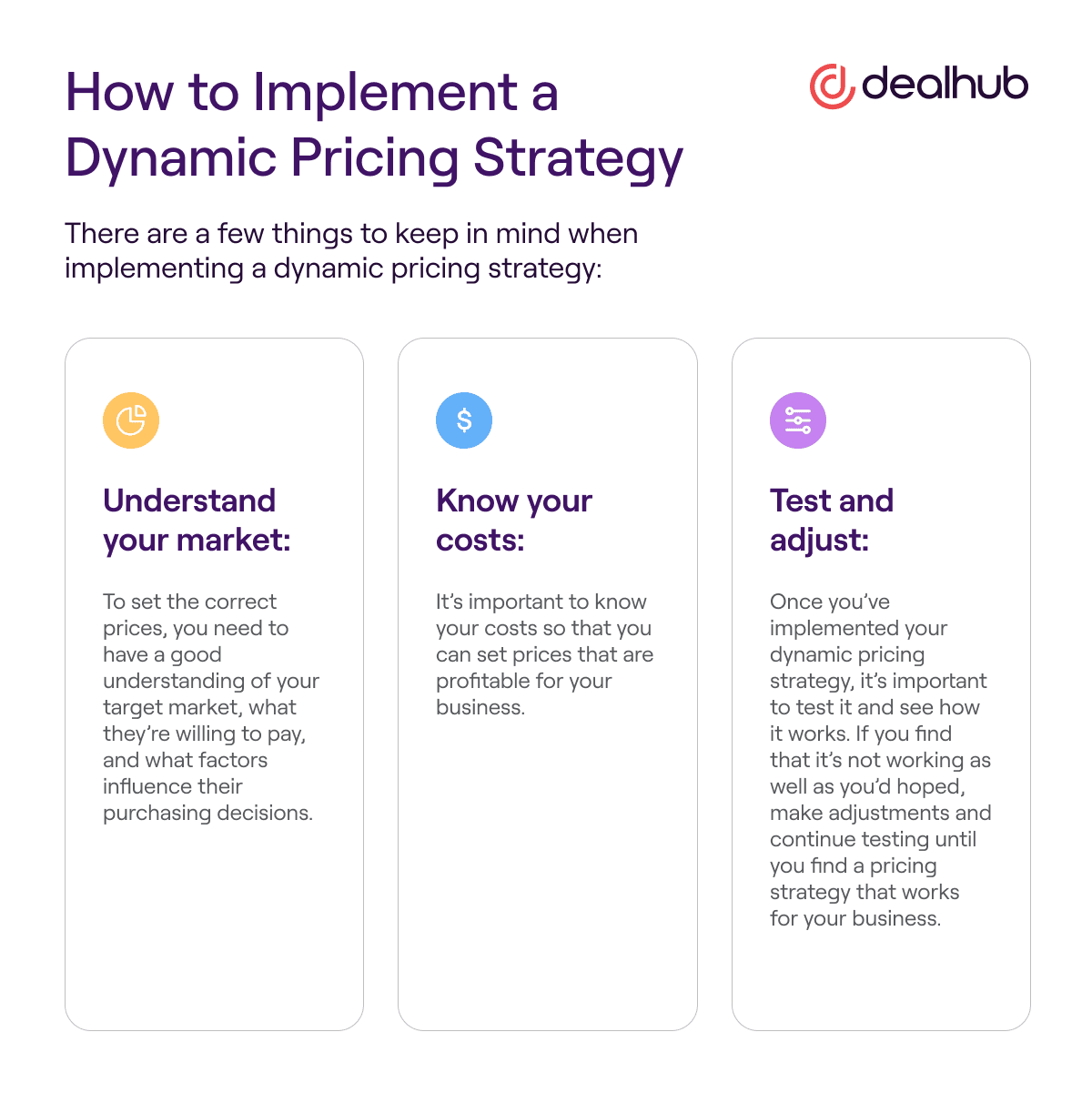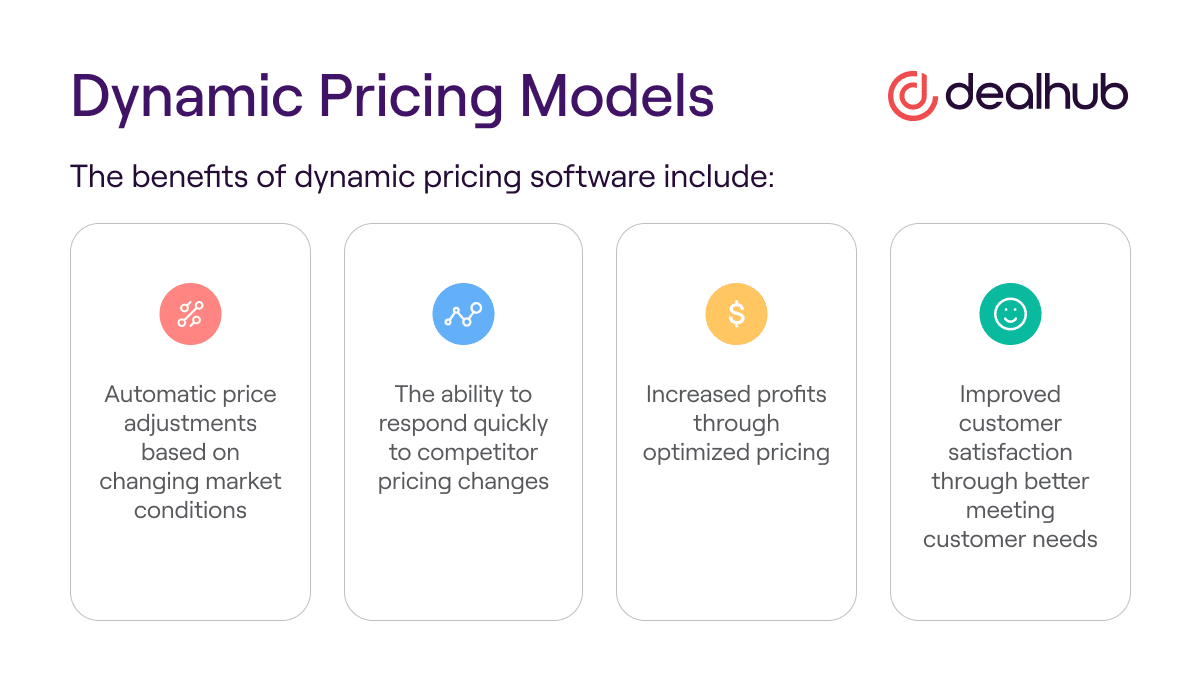Dynamic Pricing
Table of Contents
Table of Contents
What is Dynamic Pricing?
Dynamic pricing is a pricing strategy in which the price of a product or service fluctuates based on real-time market conditions. While traditionally tied to shifts in supply and demand, dynamic pricing today is also influenced by factors such as inventory levels and competitor pricing. Businesses adjust their prices dynamically using data-driven algorithms that factor in everything from current stock to how competitors are pricing similar offerings.
With the advent of technology and the trend toward digital pricing transformation, dynamic pricing has become more widespread and sophisticated. This approach is widely used across industries like transportation, energy, retail, hospitality, and entertainment. Airlines, for example, raise prices as seat availability decreases, while eCommerce retailers may lower prices to stay competitive or clear excess inventory.
Although the concept has been around for centuries (think seasonal produce priced higher at peak freshness), modern dynamic pricing is far more sophisticated. With advances in technology and data analytics, companies can now automate pricing changes based on real-time inputs, enabling strategies like surge pricing, flash sales, and personalized offers.
While dynamic pricing can spark debate over fairness, it also allows businesses to maximize revenue and consumers to take advantage of lower prices when demand is low. When used transparently, it can create value for both sides of the transaction.
Synonyms
- Surge pricing
- Demand pricing
- Real-time pricing
- Time-based pricing
- Situational pricing
- Flexible pricing
How Dynamic Pricing Works
Dynamic pricing operates on the foundational economic principle of supply and demand, but in a far more sophisticated, real-time context. Today’s dynamic pricing strategies go beyond simply reacting to demand fluctuations; they incorporate data on inventory levels, competitor pricing, time-based trends, and customer behavior to optimize revenue at every stage of the buying cycle.
For enterprise organizations, especially those with complex product catalogs or high-volume transactions, dynamic pricing offers a scalable way to maximize profitability and improve pricing agility. It’s commonly used in industries where demand fluctuates, like travel, hospitality, and events, but is increasingly adopted across eCommerce, SaaS, and B2B sectors.
Revenue operations leaders can leverage dynamic pricing to fine-tune monetization strategies, for example adjusting prices by time of day, customer segment, or channel. It also enables tactical moves like launching limited-time offers or responding instantly to competitor activity.When powered by real-time data and automation, dynamic pricing becomes a strategic lever for improving margins, accelerating sales velocity, and driving predictable growth.
Benefits of Dynamic Pricing
Dynamic pricing has become more prevalent as businesses look for ways to increase profits and respond to competition. Dynamic pricing is a pricing strategy that offers many benefits for businesses. Businesses can set prices based on demand to improve their profitability, increase sales, and reduce costs. Additionally, dynamic pricing can help companies compete more effectively by responding quickly to changes in the market. There are many benefits of dynamic pricing, including:
- Improved profitability: Businesses can maximize their profits by setting prices based on demand. Dynamic pricing also allows businesses to react quickly to changes in the market, which can help them avoid losses.
- Increased sales: Dynamic pricing can encourage customers to buy items they may not have purchased at a fixed price. This is because dynamic prices can be lower than the original price, making products more affordable for customers.
- Increased customer satisfaction: Dynamic pricing allows businesses to meet the needs of their customers by giving them the ability to pay what they feel is fair for a product or service. Dynamic pricing can also help businesses offer discounts to customers who are willing to buy in bulk or at off-peak times.
- Reduced costs: Dynamic pricing can help businesses reduce costs by avoiding the need to offer discounts or promotions. This is because dynamic prices can be set to reflect the current market conditions, which can help businesses save money.
- Improved competitiveness: Businesses can compete more effectively by responding quickly to changes in the market. This is because businesses that use dynamic pricing can adjust their prices in real-time, giving them a significant advantage over static pricing.
Who Uses Dynamic Pricing
Businesses using dynamic pricing can change prices multiple times a day, in real-time, to react to changes in demand. This data-driven price optimization strategy is commonly used in industries with a lot of competition and where prices often fluctuate.
Dynamic pricing can be a very effective way to increase sales and margins, but it can also be risky. If dynamic pricing is not done carefully, it can alienate customers and damage relationships with suppliers. When dynamic pricing is done well, it can be a win-win for both businesses and customers. Customers benefit from getting the products they want at a fair price, while businesses increase sales and margins.
The following are some industries where dynamic pricing is commonly used:
- Airline industry: Airlines have used dynamic pricing for years to maximize revenue. Flight prices can fluctuate multiple times a day based on factors such as demand, time of day, and length of the flight.
- Hotel industry: Hotels also use dynamic pricing to fill rooms during slow periods and increase rates during busy times. Rates can fluctuate based on seasonality, demand, and location.
- Event ticketing industry: Event ticket prices can fluctuate based on demand, time of day, and seat location. Dynamic pricing is commonly used for tickets to sporting events, concerts, and theatre performances.
- Retail industry: Retailers increasingly use dynamic pricing to compete with eCommerce businesses. Product prices can fluctuate based on demand, time of day, and location.
- Manufacturing: Manufacturers can adjust product pricing based on real-time cost fluctuations. Dynamic price adjustments help preserve margins without waiting for quarterly pricing reviews.
How to Implement a Dynamic Pricing Strategy
Dynamic pricing is a powerful sales enablement tool that can help businesses stay competitive, optimize revenue and profit margins, build customer loyalty, and manage risk.
There are a few things to keep in mind when implementing a dynamic pricing strategy:
- Understand your market: To set the correct prices, you need to have a good understanding of your target market, what they’re willing to pay, and what factors influence their purchasing decisions.
- Know your costs: It’s important to know your costs so that you can set prices that are profitable for your business.
- Test and adjust: Once you’ve implemented your dynamic pricing strategy, it’s important to test it and see how it works. If you find that it’s not working as well as you’d hoped, make adjustments and continue testing until you find a pricing strategy that works for your business.

Dynamic Pricing Models
Dynamic pricing strategies allow businesses to adjust prices in real time based on market signals, customer behavior, and internal factors like inventory or cost. Below are the most common dynamic pricing models used to increase revenue and improve pricing agility:
Time-based pricing: Prices fluctuate depending on the time of day, week, season, or year. This is common in industries with predictable peaks in demand (e.g., travel, utilities, or manufacturing with seasonal cycles).
Demand-based pricing: Also called surge pricing, this model increases prices when demand spikes and reduces them when demand drops. It’s widely used in transportation, events, and eCommerce.
Competitive pricing: Prices are adjusted dynamically based on competitor pricing. Real-time monitoring tools allow businesses to stay competitive without constant manual intervention.
Cost-plus dynamic pricing: Prices are automatically adjusted based on changes in production or procurement costs, ensuring margin protection even when inputs fluctuate.
Segmented or price discrimination: Different customer segments (e.g., by geography, purchase history, or device type) are offered different prices based on perceived willingness to pay.
Performance-based pricing: Prices are adjusted based on performance metrics such as customer lifetime value (CLTV), sales velocity, or conversion rate.

Leverage Dynamic Pricing Software for Scalable Revenue Impact
Dynamic pricing software uses advanced algorithms and real-time data to help businesses automatically adjust prices based on multiple factors, including demand, inventory levels, competitor pricing, and customer behavior.
At the enterprise level, dynamic pricing solutions can be integrated via APIs with ERP, CRM, CPQ, and eCommerce platforms, enabling seamless, automated pricing decisions across channels.
By embedding pricing intelligence directly into your revenue tech stack, you can ensure pricing remains agile, competitive, and aligned with your broader revenue goals.
Key benefits of dynamic pricing software include:
- Real-time, automated price adjustments based on market dynamics, customer segments, and inventory changes
- Faster response to competitor pricing changes through API-connected pricing data feeds
- Revenue growth through margin-optimized pricing tailored to customer behavior and demand signals
- Improved customer experience and conversion rates by delivering the right price at the right time
- Scalable pricing operations that reduce manual work and pricing errors across large product catalogs and global markets
How CPQ Software Enables Dynamic Pricing
For B2B sales, dynamic pricing delivers accurate, timely, and context-aware prices during the quoting process. That’s where CPQ software plays a critical role.
By integrating dynamic pricing rules and real-time data sources into the CPQ workflow, businesses can ensure sales reps generate quotes that reflect current market conditions, customer segmentation, and internal pricing strategies.
Key ways CPQ software supports dynamic pricing:
- Real-time price updates based on changes in costs, inventory, or competitor pricing
- APIs that connect to ERP, CRM, and pricing engines for up-to-date pricing intelligence
- Segmented pricing rules tailored by geography, deal size, or customer tier
- Automated discounting and approval workflows that align with margin protection policies
- Data-driven pricing recommendations that guide sales reps to optimal pricing strategies
Dynamic pricing powered by CPQ ensures quotes are not only accurate but also optimized for revenue, speed, and customer satisfaction, making it a critical capability for modern revenue operations teams.
People Also Ask
What is an example of dynamic pricing in B2B?
An example of dynamic pricing in B2B is a manufacturing company adjusting prices for components based on fluctuations in raw material costs and real-time order volume. For instance, a supplier of industrial fasteners may automatically increase prices when steel prices rise or when inventory is low, and offer volume-based discounts when customers place large bulk orders.
In this scenario, dynamic pricing is often managed through a CPQ system that integrates with ERP and pricing engines via APIs. This setup allows sales teams to generate quotes that reflect current market conditions, customer-specific agreements, and internal pricing rules, ensuring both margin protection and pricing agility.
When should a company use dynamic pricing?
Dynamic pricing can be a valuable tool for businesses that want to maximize profits and respond quickly to changes in the market, as well as those that value creating a customized buying experience.
Dynamic pricing can also help businesses clear inventory quickly, as prices can be reduced to encourage sales. Dynamic pricing can work well for businesses with perishable goods, such as food or flowers, as these goods need to be sold quickly before they go bad.
Dynamic pricing can also be effective for businesses with high-demand products or services, such as concert tickets or hotel rooms.
By using dynamic pricing, these businesses can increase prices when current market demand is high and decrease costs when demand is low, which can help maximize profits.
What are the advantages and disadvantages of dynamic pricing?
Dynamic pricing has many advantages, including increased revenue, improved customer satisfaction, and greater flexibility.
However, dynamic pricing also has some disadvantages, such as the potential for price gouging, negative customer perceptions, and challenges with implementing a dynamic pricing strategy.
Is dynamic pricing fair?
There has been much debate over whether or not dynamic pricing is fair. On the one hand, some argue that it is a way for businesses to take advantage of consumers during times of high demand.
On the other hand, others argue that dynamic pricing is simply a way to reflect a product’s or service’s actual value and that it is ultimately up to the consumer to decide whether or not they are willing to pay the higher price.



